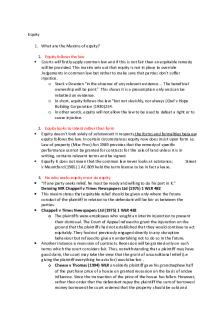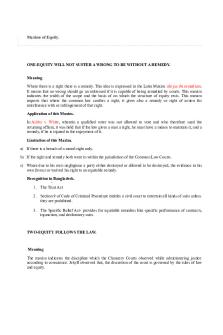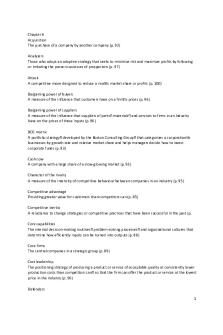Equity maxims - Key Notes for main exams. PDF

| Title | Equity maxims - Key Notes for main exams. |
|---|---|
| Author | Divya Lakhani |
| Course | Equity and Trusts |
| Institution | University of Brighton |
| Pages | 6 |
| File Size | 171.9 KB |
| File Type | |
| Total Downloads | 80 |
| Total Views | 224 |
Summary
Key Notes for main exams....
Description
Equity 1. What are the Maxims of equity?
1. Equity follows the law Courts will firstly apply common law and if this is not fair then an equitable remedy will be provided. This maxim sets out that equity is not in place to overrule Judgements in common law but rather to make sure that parties don’t suffer injustice. o Stack v Dowden “in the absence of any relevant evidence … The beneficial ownership will be joint.” This shows it is a presumption only and can be rebutted on evidence. o In short, equity follows the law “but not slavishly, nor always (Graf v Hope Building Corporation (1930)254. o In other words, equity will not allow the law to be used to defeat a right or to cause injustice.
2. Equity looks to intent rather than form Equity doesn’t look solely of substance- it respects the forms and formalities because equity follows the law. In certain circumstances equity now does insist upon form i.e. Law of property (Misc Prov) Act 1989 provides that the remedy of specific performance cannot be granted for contracts for the sale of land unless it is in writing, contains relevant terms and be signed. Equally it does not mean that the common law never looks at substance; Street v Mountford (1985) 1 AC 809 held the term license to be in fact a lease.
3. He who seeks equity must do equity “If one party seeks relief, he must be ready and willing to do his part in it.” Denning MR Chappell v Times Newspapers Ltd (1975) 1 WLR 482 This maxim states that equitable relief should be given only where the future conduct of the plaintiff in relation to the defendant will be fair as between the parties. Chappell v Times Newspapers Ltd (1975) 1 WLR 482 o The plaintiffs were employees who sought an interim injunction to prevent their dismissal. The Court of Appeal refused to grant the injunction on the ground that the plaintiffs had not established that they would continue to act equitably. They had not previously engaged directly in any disruptive behaviour but refused to give an undertaking not to do so in the future. Another instance is recession of contracts. Recession will be granted only on such terms which the court considers fair. Thus, notwithstanding that a plaintiff may have good claim, the court may take the view that the grant of unconditional relief (i.e giving the plaintiff everything he asks for) would be fair . o Cheese v Thomas (1994) WLR an elderly plaintiff gave his grandnephew half of the purchase price of a house on granted recession on the basis of undue influence. Since the transaction of the price of the house has fallen. However, rather than order that the defendant repay the plaintiff the sum of borrowed money borrowed the court ordered that the property should be sold and
both parties should bear the loss on the sale, in same proportion as they contributed to purchase; doing so would be fair to both parties and not to the plaintiff alone. 4. He who comes to equity must come with clean hands Relief will be refused if the applicant has been guilty of misconduct in events leading to the application. Tinsley v Milligan:
The parties had purchased a house and in order to defraud the department of social security they registered it in the plaintiff’s name only. Later they fell out, the plaintiff claimed possession, and the defendant counter-claimed that she had an equitable interest equivalent to her financial contribution. The plaintiff argued that the counterclaim could not be entertained because the defendant lacked clean hands. Tinsley v Milligan [1994] 1 AC 340 The HL were more flexible in regard to the maxim: ‘[S]ince both the plaintiff and the defendant had been party to the fraud and since the illegality was not of a continuing nature, it would not be an affront to the public conscience to grant the relief sought by the defendant and that her counter-claim did not arise ex turpi causa so as to deny her relief.’ Most important point established here is to whether neither party came to the court with clean hands. The courts will then decide whose hands are the dirtiest; the house was of the view it was not an affront to the public, conscience to take this approach. In this case the court decided that the parties were equally bad (court decide the varying degrees of inequity to do so as it would leave the door open for less worthy cases). 5. Equity Imputes and intention to fulfill and obligation
Equity imputes an intention to fulfill a legal, but not a moral, obligation. The maxim states that when a person is under an obligation to perform an act and does some other act which could be regarded as fulfillment of that original obligation, it will be so regarded in equity.
6. Delay defeats Equity This maxim states that where there has been unreasonable delay that has caused prejudice to the defendant a plaintiff may be denied his claim in equity. Delay alone is not enough; there must be prejudice to the defendant.
Smith v Clay (1767) 3 Bro CC 639 at 640:
“A court of equity ...has always refused its aid to stale demands, where a party has slept upon his right and acquiesced for a great length of time. Nothing can call forth this court into activity but conscience, good faith, and reasonable diligence
It is expressed in the phrase vigilantibus, non dormientibus jura subveniunt (the law assists the vigilant, not those who sleep and as Hanbury puts it: ‘equity aids the vigilant and not the indolent’.
The maxim reflects the equitable doctrine of laches: unreasonable delay that makes it unjust to grant relief. It also reflects the equitable doctrine of acquiescence: the failure to respond to a breach of one’s rights may be such that equity considers that the wronged party has permitted the wrongdoer’s conduct – this permission is inferred from the plaintiff’s knowledge of wrongdoing and failure to respond.
In more recent cases the courts treat laches and acquiescence as the same defence. This is reasonable given their tendency with issues of delay to look for prejudice to the defendant. Nelson v. Rye [1996] 1 WLR 1378, per Laddie J at 1392: “[T]hese defences are not technical or arbitrary. … [T]he factors which must be taken into consideration in deciding whether the defence runs … include the period of the delay, the extent to which the defendant’s position has been prejudiced by the delay, and the extent to which that prejudice was caused by the actions of the plaintiff. … [M]ere delay alone will almost never suffice, but the court has to look at all the circumstances … and then decide whether the balance of justice or injustice is in favour of granting the remedy or withholding it.”
7. Equity will not suffer a wrong to be without a remedy
This maxim states in effect that equity will intervene to protect the right which for some reason is not protected at common law. It reflects the reason for equity itself, to alleviate the severity of common law. Whylie “Treat with caution- is of historical importance only.” In its early days this maxim nullius recedat a curia cancellariae sine remedia. Nobody will leave the chancellor’s court without a remedy.
Attempts for equity to enter a new jurisdictional ground have been resisted. RE Diplock : “If a claim in equity exists it must be shown to have an ancestry founded in history and in the practice and precedents of the Courts of Equity” Holmes v Millage; Lindley J “ It is an old mistake to suppose that because there is no remedy at law, there must be at equity
The American Courts have embraced this maxim to a wide variety of cases including landlord and tenant and constitutional matters and have used it to a wide extent.
To the contrary, UK courts have preferred to extend common law. Douglas v Hello! [2001] QB 967 CA extending the duty of care. Lord Nichols ‘the essence of the tort is better encapsulated now as misuse of private information’.
8. Equity acts as a personam
hi sma xi ms t a t e st ha t e qui t yr e l a t e st oape r s onr a t he rt ha nt he i rpr ope r t y . I ta ppl i e st o pr ope r t yout s i deaj ur i s di c t i onpr o vi de dt ha tade f e nda nti swi t hi nt hej ur i s di c t i on.
It affected enforcement of judgments. Under common law an order could be made putting a person in possession of land. However, the courts of equity did not impinge on the defendant’s property. They made an order against the defendant himself, and in this sense equity acted ‘in personam’. If then the defendant did not comply, equity again acted in personam by an order of contempt of court. If imprisonment did not work, an order of sequestration could be made – sequestrators were appointed to take possession of the property of the defendant and, if necessary eventually all his property, until the defendant did what was required. But that was all; the sequestrators did not transfer the property to the plaintiff.
It also bears on issues of jurisdiction over property abroad. As equity acts on the person, it is irrelevant if the property is within or outside the jurisdiction of the court provided that the person is either physically present in its jurisdiction or can be served outside the jurisdiction. We will see the importance of this maxim when we look at Mareva (Freezing) Orders.
arising under a trust is an interest in rem or in personam. In Webb v. Webb [1994] QB 696 the ECJ held that a father’s claim that his son held a flat purchased in France by the father in his son’s name in trust for the father was a claim to a right in personam rather than in rem. This decision applies in interpretation of the exclusive jurisdiction provision set down in EC Regulation No. 44/2001 on jurisdiction and the recognition and enforcement of judgments in civil and commercial matters. A conflicting decision was reached by a UK court in Re Hayward [1997] Ch 45 in which Rattee J. held that a claim by the trustee in bankruptcy of a deceased coowner to a half-share of a villa in Spain was a right in rem. He distinguished Webb on the basis that this case was in effect a claim to half the legal share. 9. Where the equities are equal the first in time prevails; Where the equities are equal, the law prevails
These two maxims apply in relation to ownership of land. This can be a very complex area in that it can involve a number of persons holding an interest in the same land. In such cases, the question of whose interest takes priority arises. Overlapping interests in land are resolved principally by the doctrine of notice, and the two maxims are the basis for this doctrine.
The doctrine states that a purchaser of land will only be bound by those equitable interests of which he had notice, be that actual, constructive or imputed notice.
Where a bona fide purchaser of the legal estate acquires property without notice, the legal estate will prevail. This is an application of the maxim, where the equities are equal, the law prevails.
Where the purchaser of the legal estate has notice of a prior equitable interest, he does not take free of it. If the parties in conflict hold equitable interests only, the first in time prevails.
Where there is a bona fide purchaser of a legal estate for value without notice of a prior equitable interest/mere equity that purchaser can take the property free of that equitable interest (the legal interest trumps the equitable interest). Where there is a bona fide purchaser of an equitable estate for value without notice of a prior equitable interest that purchaser will take the property subject to the prior equitable interest but can take free of any prior mere equities. The Equitable Principles Legal Interest v Legal Interest Solution: first in time prevails. Exception: where the first in time has been tainted by fraud, gross negligence relating to the title deeds etc. Equitable v Equitable Solution: first in time prevails. Exception: where the holder of the first equitable interest has tainted the equities by fraud or negligence (not gross negligence). Prior legal Interest v later equitable Interest Solution: legal estate has priority, because: it is the first in time; legal estates will normally be granted priority over equitable interests. Exception: where the holder of the legal estate has done something to introduce an inequality in the equities. Prior equitable Interest v Later legal Interest Solution: either the later taker of the legal interest was a bona fide purchaser who takes untethered by earlier equitable interest; or the first equitable interest will prevail.
2. Do the Maxims of Equity have much practical use today?
The maxims of equity are the general principles if equity that were developed by the Court of chancery. The maxims are merely general principles not positive or mandatory rules of equity. Also, they may develop or indeed conflict with each other. For those reasons they do not apply literally in any given case. In certain cases, particularly in relation to property some maxims lay down rules – if equitable claims are equal, the first in time prevails. There are now 14 Maxims of equity (many others have been lost through time).
3. Equity must come with clean hands, cash ‘under the counter’, The delay has to be prejudice – has the delay, the plaintiff has caused. There has been a expenditure of money. Prejudice has to be different things. Looking it from an equitable perspective...
Similar Free PDFs

Maxims of Equity Equity Law
- 5 Pages

Lecture Notes Maxims of Equity 27
- 27 Pages

CRPC Notes for Exams
- 117 Pages

Coownership Notes FOR Exams
- 16 Pages

Legal Maxims - Lecture notes 54
- 10 Pages

Equity notes
- 58 Pages

Equity Notes
- 41 Pages

Main terms for pharmacology
- 9 Pages
Popular Institutions
- Tinajero National High School - Annex
- Politeknik Caltex Riau
- Yokohama City University
- SGT University
- University of Al-Qadisiyah
- Divine Word College of Vigan
- Techniek College Rotterdam
- Universidade de Santiago
- Universiti Teknologi MARA Cawangan Johor Kampus Pasir Gudang
- Poltekkes Kemenkes Yogyakarta
- Baguio City National High School
- Colegio san marcos
- preparatoria uno
- Centro de Bachillerato Tecnológico Industrial y de Servicios No. 107
- Dalian Maritime University
- Quang Trung Secondary School
- Colegio Tecnológico en Informática
- Corporación Regional de Educación Superior
- Grupo CEDVA
- Dar Al Uloom University
- Centro de Estudios Preuniversitarios de la Universidad Nacional de Ingeniería
- 上智大学
- Aakash International School, Nuna Majara
- San Felipe Neri Catholic School
- Kang Chiao International School - New Taipei City
- Misamis Occidental National High School
- Institución Educativa Escuela Normal Juan Ladrilleros
- Kolehiyo ng Pantukan
- Batanes State College
- Instituto Continental
- Sekolah Menengah Kejuruan Kesehatan Kaltara (Tarakan)
- Colegio de La Inmaculada Concepcion - Cebu







